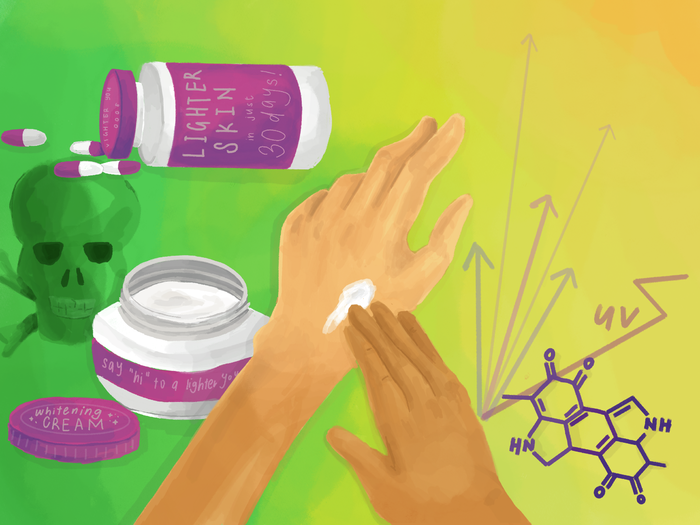Why brown girls don’t sunbathe
Roshni Ranasinghe-de Silva explores the impact of colourism on South Asian beauty standards

To my classmates, summer term meant lazy hours spent lounging on the grass, playing football, sunbathing. But every time someone suggested spending a break like this, I was reluctant. Another hour in the sun only meant that I was going to become darker. Over the years, I developed methods to avoid the sun: sit under a tree, place a jumper over my head in a feeble attempt to shield my face. People made light-hearted jokes: Why are you always in the shade? Are you scared of the sun? Do you even tan?
Growing up, I could not produce a rational explanation for my fear of tanning. It was only later that I began to actively question the beauty standards that had convinced me that light skin was inherently more attractive than darker skin. Looking back, I can see that I clearly succumbed to these ridiculous beliefs. I would edit the brightness of my pictures and use Snapchat filters designed to make my skin look lighter (of which, by the way, there are many).
Back then, there was no point in explaining to my all-white friendship group that the reason I avoided the sun was that I did not want to grow darker. Tan lines were a victory to them, but a defeat to me. They wouldn’t get it - how could they? Western cultures idealise tanned skin as a beauty standard for women in the same way Asian cultures venerate fair skin - it’s a twisted version of the grass being greener on the other side.
“As the European settlers arrived, they brought their white ideals with them”
At Cambridge University, hearing stories from other South Asian girls opened my eyes to the universality of this problem. These girls, like me, brought umbrellas to park meetups, wore long-sleeved clothing, and avoided the sun like the plague. The collateral impact on our self-confidence perpetuates an unfortunate aspect of reality for many women: that our worth is somehow judged by our beauty.
Colourism has always carried historic weight in South Asia, but it flourished under colonialism. Whiteness symbolised power. Sri Lanka was colonised by the Portuguese, Dutch and British and, as the European settlers arrived, they brought their white ideals with them. The perception that fairness illustrated class, beauty, and wealth has grown unshakeable roots in modern culture.
On each of my annual visits to Sri Lanka, I see billboards decorated with heavily edited light-skinned models and witness offhand comments made by opinionated aunties. Colourism is unashamedly ubiquitous - you just have to turn on the TV. The simple (yet telling) reality is that in most TV dramas, Hindi and Tamil movies, the main actresses are light-complexioned. Take the Indian sweethearts Aishwarya Rai and Deepika Padukone, for example. Both are undeniably beautiful. Both are also undeniably light-skinned.
The main languages spoken in Sri Lanka are Sinhalese, Tamil and English. In Sinhalese, a light-skinned girl may be called “sudu kela”, whereas a girl with a darker complexion would be called a “kalu kela”. The literal translation: “white girl” and “black girl”. Likewise, in Tamil, the words “vellai” (white) and “karuppu” (black) serve as the only descriptors for skin tone. The harshness of the language itself furthers these problematic associations, deepening prejudice and eradicating any sense of nuance.
“Challenging colourism within my daily routine requires active mental commitment”
I asked my aunt, who lives in Colombo, to send me examples of ‘successful women’ in Sri Lanka at the moment. While I appreciate this is a somewhat vague request, she sent me a selection that included Rosy Senanayake (Present Mayoress of Colombo), Caroline Jurie (Miss World, 2020), and Jacqueline Fernandez (Bollywood actress and former Miss Universe, 2006). At the end of the WhatsApp message, however, without any knowledge of this article, she added: “All fair-skinned and beautiful!”. The affiliation of beauty with fair skin is so ingrained that, for many, it feels perfectly natural to link the two concepts. It is also striking that two out of three women chosen are globally recognised models – the supposedly highest specimen forms of beauty.
Whitening creams and skin-lightening procedures form a multi-billion rupee market in Sri Lanka. The mere existence of brands like Fair & Lovely reinforce the problem of colourism: Asian cosmetic companies understand that fair skin is a form of social currency. But it isn’t just Asian businesses that capitalise on this - international brands such as Dove, Vaseline, Garnier, and Nivea have all faced criticism for similar marketing. Of course, colourism existed long before Fair & Lovely did, but the fact that modern companies embrace these standards demonstrates the true exploitative nature of the issue. Failing to recognise the underlying motivation behind such marketing allows cosmetic industries to passively normalise whiteness as the paradigm of beauty.
There has, however, been progress. Concerted efforts to dismantle colourism within South Asia include the students who started the #unfairandlovely hashtag, the ‘Dark is Beautiful’ campaign by Women of Worth, and the ‘Dark Is Divine’ anti-colourism movement launched by Fatima Lodhi. Nayani Thiyagarajah (Sri Lankan director and producer) recently released her documentary Shadeism, and Unilever has agreed to drop the word “fair” from its branding, adopting instead to “Glow & Lovely”. Though this perhaps represents performative change, the heightened scrutiny and lower tolerance towards such brands demonstrates a degree of progress in itself.
In 2017, Rihanna launched Fenty Beauty, which garnered international popularity and rocked the beauty industry to its core. I was astonished by the 40 available foundation shades - an unparalleled instance of diversity on the makeup stage. Her website itself utilises language such as ‘lighter’ and ‘deeper’, cleverly avoiding the stigmatic connotations of the term ‘dark’.
On a personal level, the first step to overcoming ingrained insecurity is to accept the issue. You cannot solve a problem you refuse to recognise. Challenging colourism within my daily routine requires active mental commitment – checking myself every time I succumb to prejudiced standards and questioning the ‘ideals’ I am expected to aspire to.
I have grown into my skin. Nowadays, I can wear sleeveless tops confidently and sit outside relatively unagitated in summer, without desperately seeking shade the way I used to. And while you will still never catch me actually sunbathing, that’s only because my mum is a dermatologist!
 News / Cambridge bus strikes continue into new year16 January 2026
News / Cambridge bus strikes continue into new year16 January 2026 News / Local business in trademark battle with Uni over use of ‘Cambridge’17 January 2026
News / Local business in trademark battle with Uni over use of ‘Cambridge’17 January 2026 News / Uni members slam ‘totalitarian’ recommendation to stop vet course 15 January 2026
News / Uni members slam ‘totalitarian’ recommendation to stop vet course 15 January 2026 Interviews / The Cambridge Cupid: what’s the secret to a great date?14 January 2026
Interviews / The Cambridge Cupid: what’s the secret to a great date?14 January 2026 Science / Why smart students keep failing to quit smoking15 January 2026
Science / Why smart students keep failing to quit smoking15 January 2026










